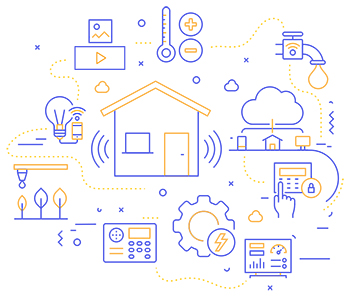This month, we focus on the impact of smart technology on the High-Performance HVAC Industry. Yes, smart technology, or smart tech, has been around for a long time. Once considered a fad, this technology makes deeper inroads into the psyche of the American consumer and the HVAC business owner each year.
It started with smart control of lighting, kitchen appliances, and even residential security systems. But with the 21st Century push on better environmental management and reducing the energy load of a home’s largest energy consumer – the HVAC system – smart tech is more important than ever to homeowners.
Some Statistics to Consider
In a study posted on the Statista website, the total number of smart homes in the U.S. could go beyond the 78 million mark by 2024! Controlling consumer electronics has led the way in this phenomenon, but with the introduction of smart thermostats, companies like Nest, Amazon, Google, and others entered the HVAC arena.
So, what does this mean for the average HVAC service and installation technician? First, most smart tech can alert homeowners in advance of problems.

In the case of smart HVAC systems, the technology can add to the complexity of equipment, requiring technicians to be trained to use and interpret the information generated by it.
In his article, “Smart Technology and the High-Performance HVAC Professional,” contractor Eddie McFarlane explains what this could mean for today’s HVAC technicians and the companies they work for. He outlines some key advantages, especially for High-Performance HVAC contractors, regarding smart monitoring opportunities, predictive maintenance, and more.
McFarlane talks about the importance of testing, measuring, and diagnosing based on real information as the philosophy of the high-performance professional. He says that it’s not a far stretch to add to the data collection in terms of monitoring so contractors can predict issues, and use that knowledge to correct them before they even come to the customer’s attention.
Also in this Issue
Also, in this issue, David Richardson talks about using digital instruments to help collect data on your service and install calls. Check out his article, “Upgrade Your Duct Testing with State-of-the-Art Software and Tools,” to learn more about that.
The common thread is training. Alana Ward, owner of Baggett Heating and Cooling in Clarksville, TN, shares how virtual training helps keep her technicians sharp in the high-performance HVAC world. Read her article, “Shortening the Learning Curve in the Digital Age,” in this issue.
What does it require for you to take advantage of these smart opportunities? Start with what you know: Smart temperature controls. Manufacturers have onboarded sensors into their HVAC equipment and components for years, and thermostat technology today makes better use of them to run continuous diagnostics helping homeowners save energy and money on their utility bills.
This includes zone management, carbon monoxide detection, remote control through mobile apps, and so much more.
With built-in Wi-Fi, smart technology can also send you alerts when it’s time for annual or routine maintenance so homeowners’ systems run smoothly and last longer.
So, do you think Smart Tech is ready for prime time? Are you considering whether to make it part of your High-Performance offerings? I’d love to know your thoughts on this. Drop me a note at ncilink.com/ContactMe.













Recent Comments